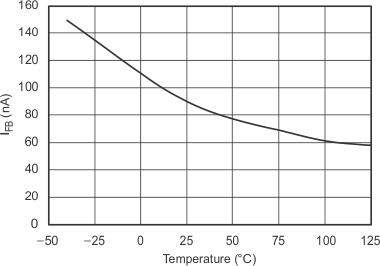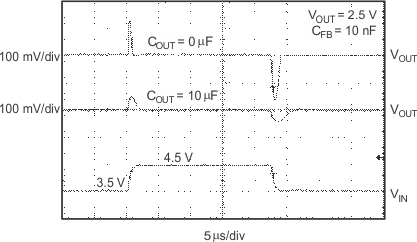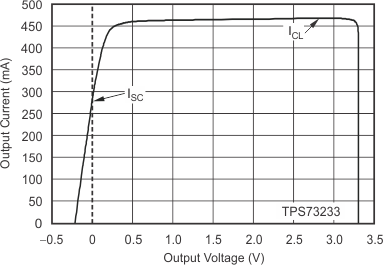SBVS037P August 2003 – December 2015 TPS732
PRODUCTION DATA.
- 1 Features
- 2 Applications
- 3 Description
- 4 Revision History
- 5 Pin Configuration and Functions
- 6 Specifications
- 7 Detailed Description
- 8 Application and Implementation
- 9 Power Supply Recommendations
- 10Layout
- 11Device and Documentation Support
- 12Mechanical, Packaging, and Orderable Information
Package Options
Mechanical Data (Package|Pins)
Thermal pad, mechanical data (Package|Pins)
- DRB|8
Orderable Information
6 Specifications
6.1 Absolute Maximum Ratings
over operating junction temperature range (unless otherwise noted) (1)| MIN | MAX | UNIT | ||
|---|---|---|---|---|
| Voltage | VIN | –0.3 | 6 | V |
| VEN | –0.3 | 6 | ||
| VOUT | –0.3 | 5.5 | ||
| VNR, VFB | –0.3 | 6 | ||
| Peak output current | IOUT | Internally limited | ||
| Output short-circuit duration | Indefinite | |||
| Continuous total power dissipation | See Power Dissipation | |||
| Temperature | Junction range ,TJ | –55 | 150 | °C |
| Storage range, Tstg | –65 | 150 | ||
(1) Stresses beyond those listed under Absolute Maximum Ratings may cause permanent damage to the device. These are stress ratings only, which do not imply functional operation of the device at these or any other conditions beyond those indicated under Recommended Operating Conditions. Exposure to absolute-maximum-rated conditions for extended periods may affect device reliability.
6.2 ESD Ratings
| VALUE | UNIT | |||
|---|---|---|---|---|
| V(ESD) | Electrostatic discharge | Human body model (HBM), per ANSI/ESDA/JEDEC JS-001, all pins(1) | ±2000 | V |
| Charged device model (CDM), per JEDEC specification JESD22-C101, all pins(2) | ±500 | |||
(1) JEDEC document JEP155 states that 500-V HBM allows safe manufacturing with a standard ESD control process.
(2) JEDEC document JEP157 states that 250-V CDM allows safe manufacturing with a standard ESD control process.
6.3 Recommended Operating Conditions
over operating junction temperature range (unless otherwise noted).| MIN | NOM | MAX | UNIT | ||
|---|---|---|---|---|---|
| VIN | Input supply voltage range | 1.7 | 5.5 | V | |
| IOUT | Output current | 0 | 250 | mA | |
| TJ | Operating junction temperature | –40 | 125 | °C | |
6.4 Thermal Information
| THERMAL METRIC(1)(2) | TPS732(3) | UNIT | |||
|---|---|---|---|---|---|
| DRB [SON] | DCQ [SOT223] | DBV [SOT23] | |||
| 8 PINS | 6 PINS | 5 PINS | |||
| RθJA | Junction-to-ambient thermal resistance | 58.3 | 53.1 | 205.9 | °C/W |
| RθJC(top) | Junction-to-case (top) thermal resistance | 93.8 | 35.2 | 119 | |
| RθJB | Junction-to-board thermal resistance | 72.8 | 7.8 | 35.4 | |
| ψJT | Junction-to-top characterization parameter | 2.7 | 2.9 | 12.7 | |
| ψJB | Junction-to-board characterization parameter | 25 | 7.7 | 34.5 | |
| RθJC(bot) | Junction-to-case (bottom) thermal resistance | 5 | N/A | N/A | |
(1) For more information about traditional and new thermal metrics, see the IC Package Thermal Metrics application report, SPRA953.
(2) For thermal estimates of this device based on PCB copper area, see the TI PCB Thermal Calculator.
(3) Thermal data for the DRB, DCQ, and DRV packages are derived by thermal simulations based on JEDEC-standard methodology as specified in the JESD51 series. The following assumptions are used in the simulations:
-
i. DRB: The exposed pad is connected to the PCB ground layer through a 2 × 2 thermal via array.
. ii. DCQ: The exposed pad is connected to the PCB ground layer through a 3 × 2 thermal via array.
. iii. DBV: There is no exposed pad with the DBV package. -
i. DRB: The top and bottom copper layers are assumed to have a 20% thermal conductivity of copper representing a 20% copper coverage.
. ii. DCQ: Each of top and bottom copper layers has a dedicated pattern for 20% copper coverage.
. iii. DBV: The top and bottom copper layers are assumed to have a 20% thermal conductivity of copper representing a 20% copper coverage. - These data were generated with only a single device at the center of a JEDEC high-K (2s2p) board with 3-inch × 3-inch copper area. To understand the effects of the copper area on thermal performance, see the Power Dissipation section of this data sheet.
6.5 Electrical Characteristics
Over operating temperature range (TJ = –40°C to 125°C), VIN = VOUT(nom) + 0.5 V(1), IOUT = 10 mA, VEN = 1.7 V, and COUT = 0.1 μF, unless otherwise noted. Typical values are at TJ = 25°C.| PARAMETER | TEST CONDITIONS | MIN | TYP | MAX | UNIT | |||
|---|---|---|---|---|---|---|---|---|
| VIN | Input voltage range(1) | 1.7 | 5.5 | V | ||||
| VFB | Internal reference (TPS73201) | TJ = 25°C | 1.198 | 1.2 | 1.21 | V | ||
| VOUT | Output voltage range (TPS73201)(2) | VFB | 5.5 – VDO | V | ||||
| Accuracy(1)(3) | Nominal | TJ = 25°C | –0.5% | 0.5% | ||||
| VIN, IOUT, and T | VOUT + 0.5 V ≤ VIN ≤ 5.5 V; 10 mA ≤ IOUT ≤ 250 mA |
–1% | ±0.5% | 1% | ||||
| ΔVOUT(ΔVIN) | Line regulation(1) | VOUT(nom) + 0.5 V ≤ VIN ≤ 5.5 V | 0.01 | %/V | ||||
| ΔVOUT(ΔIOUT) | Load regulation | 1 mA ≤ IOUT ≤ 250 mA | 0.002 | %/mA | ||||
| 10 mA ≤ IOUT ≤ 250 mA | 0.0005 | %/mA | ||||||
| VDO | Dropout voltage(4)
(VIN = VOUT (nom) – 0.1 V) |
IOUT = 250 mA | 40 | 150 | mV | |||
| ZO(do) | Output impedance in dropout | 1.7 V ≤ VIN ≤ VOUT + VDO | 0.25 | Ω | ||||
| ICL | Output current limit | VOUT = 0.9 × VOUT(nom) | 250 | 425 | 600 | mA | ||
| ISC | Short-circuit current | VOUT = 0 V | 300 | mA | ||||
| IREV | Reverse leakage current(5) (–IIN) | VEN ≤ 0.5 V, 0 V ≤ VIN ≤ VOUT | 0.1 | 10 | μA | |||
| IGND | GND pin current | IOUT = 10 mA (IQ) | 400 | 550 | μA | |||
| IOUT = 250 mA | 650 | 950 | ||||||
| ISHDN | Shutdown current (IGND) | VEN ≤ 0.5 V, VOUT ≤ VIN ≤ 5.5, –40°C ≤ TJ ≤ 100°C |
0.02 | 1 | µA | |||
| IFB | FB pin current (TPS73201) | 0.1 | 0.3 | μA | ||||
| PSRR | Power-supply rejection ratio (ripple rejection) |
f = 100 Hz, IOUT = 250 mA | 58 | dB | ||||
| f = 10 kHz, IOUT = 250 mA | 37 | |||||||
| Vn | Output noise voltage BW = 10Hz – 100kHz |
COUT = 10 μF, No CNR | 27 × VOUT | μVRMS | ||||
| COUT = 10 μF, CNR = 0.01 μF | 8.5 × VOUT | |||||||
| VEN(high) | EN pin high (enabled) | 1.7 | VIN | V | ||||
| VEN(low) | EN pin low (shutdown) | 0 | 0.5 | V | ||||
| IEN(high) | EN pin current (enabled) | VEN = 5.5 V | 0.02 | 0.1 | μA | |||
| TSD | Thermal shutdown temperature | Shutdown | Temp increasing | 160 | °C | |||
| Reset | Temp decreasing | 140 | ||||||
| TJ | Operating junction temperature | –40 | 125 | °C | ||||
(1) Minimum VIN = VOUT + VDO or 1.7 V, whichever is greater.
(2) TPS73201 is tested at VOUT = 2.5 V.
(3) Tolerance of external resistors not included in this specification.
(4) VDO is not measured for fixed output versions with VOUT(nom) < 1.8 V because minimum VIN = 1.7 V.
(5) Fixed-voltage versions only; refer to Application Information section for more information.
6.6 Switching Characteristics
over operating free-air temperature range (unless otherwise noted)| PARAMETER | TEST CONDITIONS | MIN | TYP | MAX | UNIT | |
|---|---|---|---|---|---|---|
| tSTR | Start-up time | VOUT = 3 V, RL = 30 Ω COUT = 1 μF, CNR = 0.01 μF |
600 | μs | ||
6.7 Typical Characteristics
For all voltage versions at TJ = 25°C, VIN = VOUT(nom) + 0.5 V, IOUT = 10 mA, VEN = 1.7 V, and COUT = 0.1 μF, unless otherwise noted.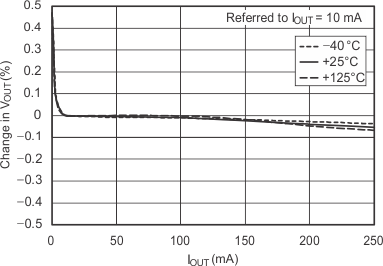

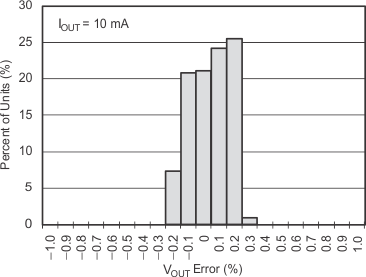

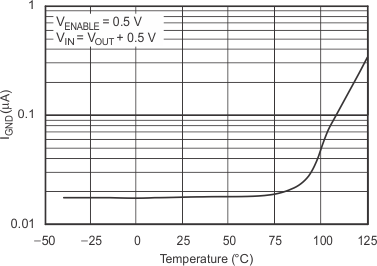
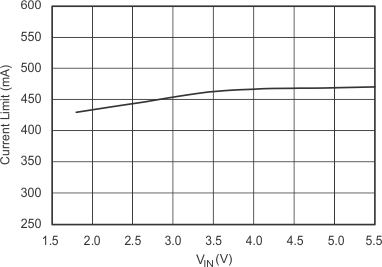
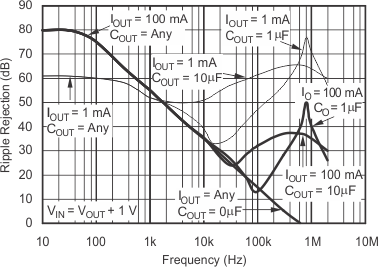
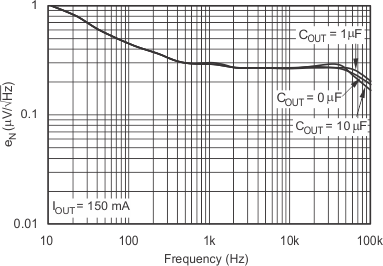

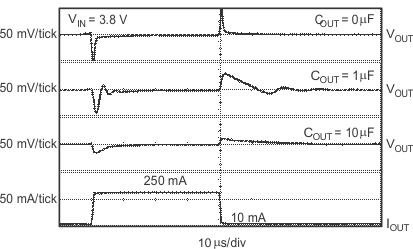
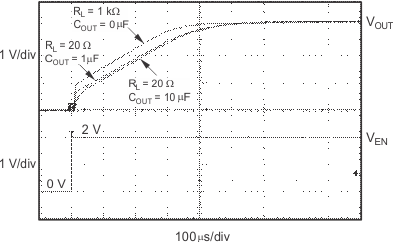
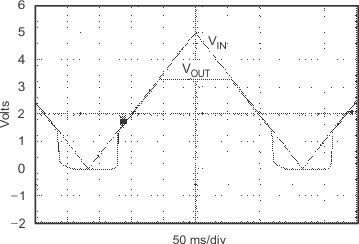
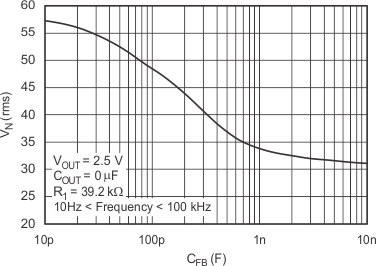
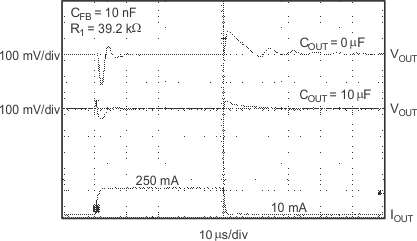
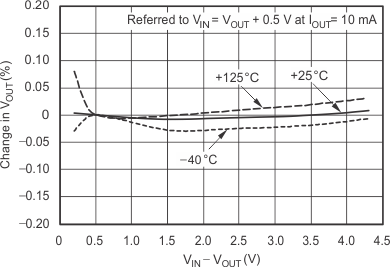
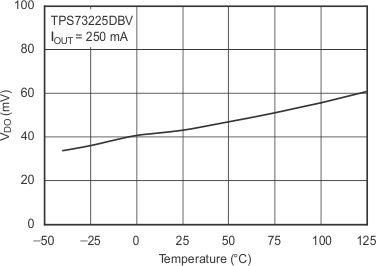
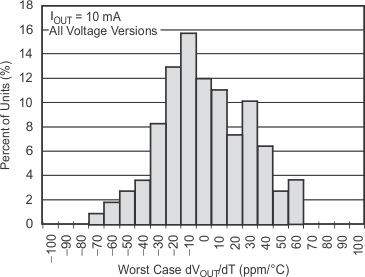
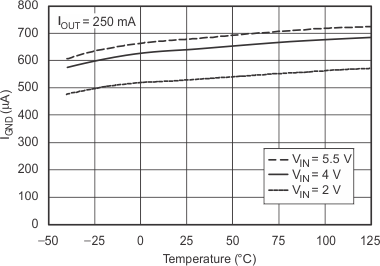
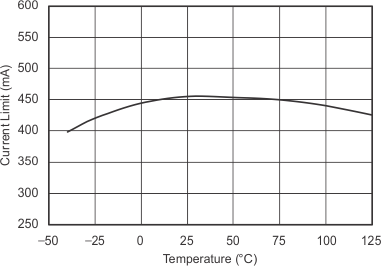
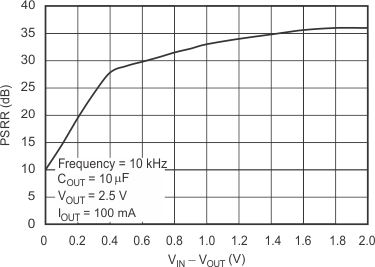
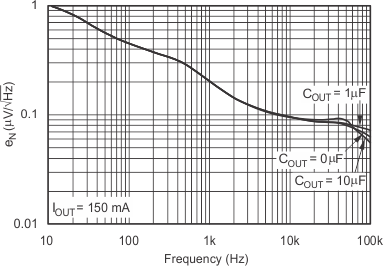
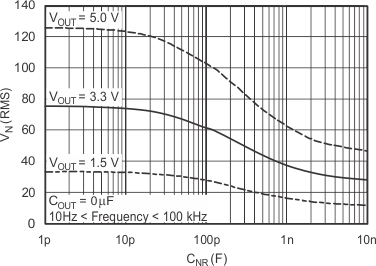
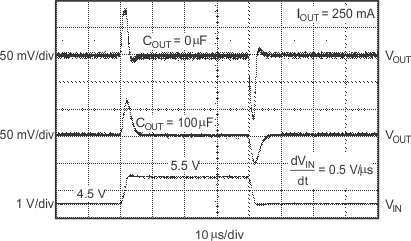
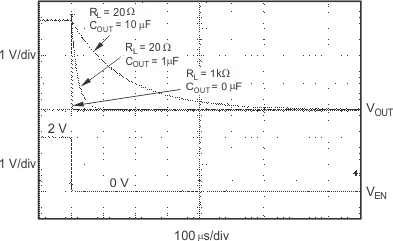
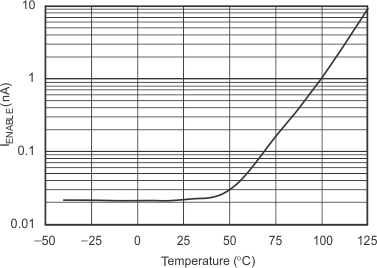
.
Figure 24. IENABLE vs Temperature
